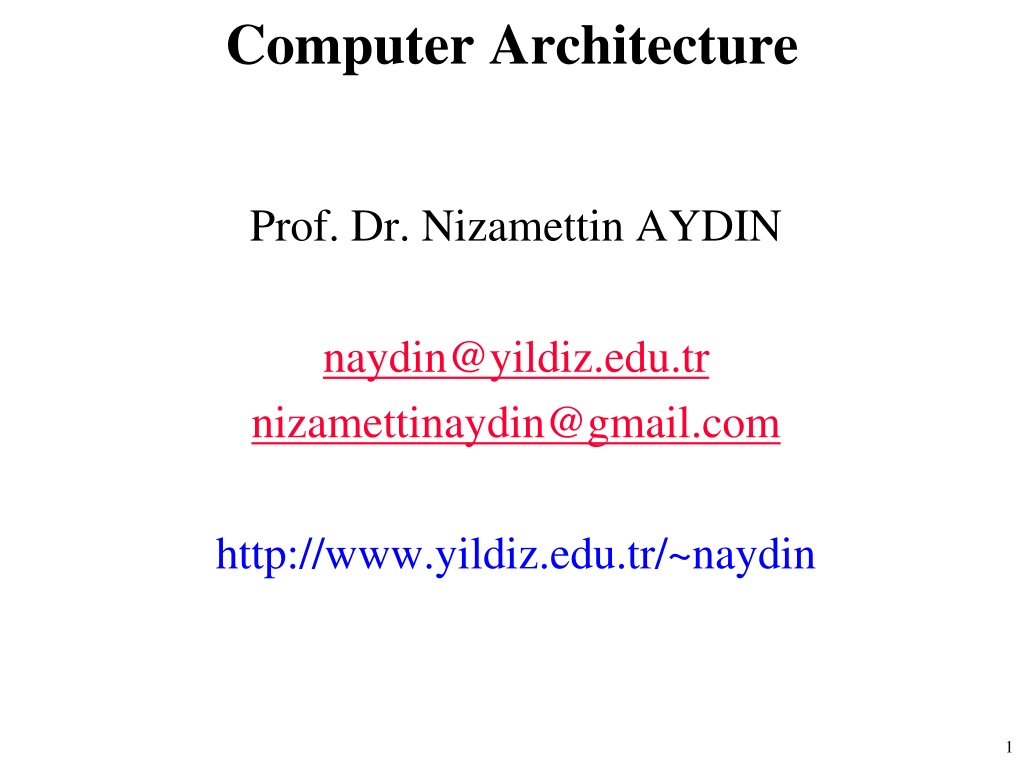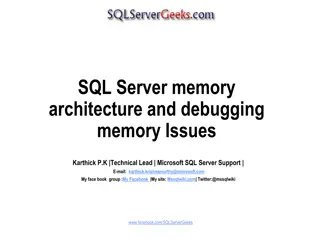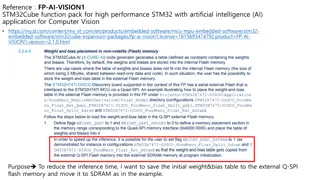Understanding External Memory in Computer Architecture
Exploring the world of external memory in computer architecture, this comprehensive guide covers topics such as magnetic disks, external memory types, data organization, disk velocity, and read/write mechanisms. Dive into the intricacies of different storage mediums like solid-state drives, optical memory, and magnetic tape, and learn about the advancements in technology that have revolutionized how data is stored and accessed.
Download Presentation

Please find below an Image/Link to download the presentation.
The content on the website is provided AS IS for your information and personal use only. It may not be sold, licensed, or shared on other websites without obtaining consent from the author. Download presentation by click this link. If you encounter any issues during the download, it is possible that the publisher has removed the file from their server.
E N D
Presentation Transcript
Computer Architecture Prof. Dr. Nizamettin AYDIN naydin@yildiz.edu.tr nizamettinaydin@gmail.com http://www.yildiz.edu.tr/~naydin 1
Outline Types of External Memory Magnetic Disk Magnetic Read and Write Mechanisms Data Organization and Formatting Physical Characteristics Disk Performance Parameters RAID Solid State Drives Flash Memory SSD Compared to HDD SSD Organization Optical Memory Compact Disk Digital Versatile Disk High-Definition Optical Disks Magnetic Tape 3
Magnetic Disk Disk substrate coated with magnetizable material (iron oxide rust) Substrate used to be aluminium Now glass Improved surface uniformity Increases reliability Reduction in surface defects Reduced read/write errors Lower flight heights Better stiffness to reduce disk dynamics Better shock/damage resistance 4
Write and Read Mechanisms During read/write, head is stationary, platter rotates Write (inductive) Current through coil produces magnetic field Pulses sent to head Magnetic pattern recorded on surface below Read (magneto resistive) (MR) Separate read head, close to write head Partially shielded magneto resistive (MR) sensor Electrical resistance depends on direction of magnetic field High frequency operation Higher storage density and speed 5
Data Organization and Formatting Concentric rings or tracks Gaps between tracks Reduce gap to increase capacity Same number of bits per track (variable packing density) Constant angular velocity Tracks divided into sectors Minimum block size is one sector May have more than one sector per block 6
Disk Velocity Bit near centre of rotating disk passes fixed point slower than bit on outside of disk Increase spacing between bits in different tracks Rotate disk at constant angular velocity (CAV) Gives pie shaped sectors and concentric tracks Individual tracks and sectors addressable Move head to given track and wait for given sector Waste of space on outer tracks Lower data density Can use zones to increase capacity Each zone has fixed bits per track More complex circuitry 7
Finding Sectors Some means is needed to locate sector positions within a track. There must be some starting point on the track and a way of identifying the start and end of each sector. These requirements are handled by means of control data recorded on the disk. Thus, the disk is formatted with some extra data used only by the disk drive and not accessible to the user. 9
Winchester Disk Format-Seagate ST506 An example of disk formatting: Each track contains 30 fixed-length sectors of 600 bytes each. Each sector holds 512 bytes of data plus control information useful to the disk controller. The ID field is a unique identifier or address used to locate a particular sector. The SYNCH byte is a special bit pattern that delimits the beginning of the field. The track number identifies a track on a surface. The head number identifies a head, because this disk has multiple surfaces. The ID and data fields each contain an error detecting code. 10
Characteristics Fixed (rare) or movable head Removable or fixed Single or double (usually) sided Single or multiple platter Head mechanism Contact (Floppy) Fixed gap Flying (Winchester) 11
Fixed/Movable Head Disk Fixed head One read write head per track Heads mounted on fixed ridged arm Movable head One read write head per side Mounted on a movable arm 12
Removable or Not Removable disk Can be removed from drive and replaced with another disk Provides unlimited storage capacity Easy data transfer between systems Nonremovable disk Permanently mounted in the drive 13
Multiple Platter One head per side Heads are joined and aligned Aligned tracks on each platter form cylinders Data is striped by cylinder reduces head movement Increases speed (transfer rate) 14
Floppy Disk 8 , 5.25 , 3.5 Small capacity Up to 1.44Mbyte (2.88M never popular) Slow Universal Cheap Obsolete? 17
Winchester Hard Disk (1) Developed by IBM in Winchester (USA) Sealed unit One or more platters (disks) Heads fly on boundary layer of air as disk spins Very small head to disk gap Getting more robust Universal Cheap Fastest external storage! Getting larger all the time Terabyte now easily available 18
Typical Hard Disk Drive Parameters Parameters for typical contemporary high-performance disks 19
Timing of Disk I/O Transfer The actual details of disk I/O operation depend on the computer system, the operating system, and the nature of the I/O channel and disk controller hardware. A general timing diagram of disk I/O transfer: 20
Disk Performance Parameters-Speed Seek time Moving head to correct track (Rotational) latency Waiting for data to rotate under head Transfer time Depends on the rotation speed of the disk Access time = Seek + Latency r 2 T: transfer time, b: number of bytes to be transferred, N: number of bytes on track, r: rotation speed, in revolution per sconds b T = rN 1 b = + + Ts: average seek time T T s rN Transfer rate 21
RAID Redundant Array of Independent Disks Redundant Array of Inexpensive Disks 6 levels in common use Not a hierarchy Set of physical disks viewed as single logical drive by O/S Data distributed across physical drives Can use redundant capacity to store parity information 22
RAID 0 No redundancy Data striped across all disks Round Robin striping Increase speed Multiple data requests probably not on same disk Disks seek in parallel A set of data is likely to be striped across multiple disks 23
RAID 1 Mirrored Disks Data is striped across disks 2 copies of each stripe on separate disks Read from either Write to both Recovery is simple Swap faulty disk & re-mirror No down time Expensive 24
RAID 2 Disks are synchronized Very small stripes Often single byte/word Error correction calculated across corresponding bits on disks Multiple parity disks store Hamming code error correction in corresponding positions Lots of redundancy Expensive Not used 25
RAID 3 Similar to RAID 2 Only one redundant disk, no matter how large the array Simple parity bit for each set of corresponding bits Data on failed drive can be reconstructed from surviving data and parity info Very high transfer rates 26
Example: Data reconstruction in RAID3 Consider an array of five drives (X0,X1,X2,X3 contain data, X4 is parity disk) Parity of ith bit is calculated as: X4(i)=X3(i) X2(i) X1(i) X0(i) Suppose that drive X1 has failed. The contents of X1 can be regenerated as: X1(i)=X4(i) X3(i) X2(i) X0(i) 27
RAID 4 Each disk operates independently Good for high I/O request rate Large stripes Bit by bit parity calculated across stripes on each disk Parity stored on parity disk 28
RAID 5 Like RAID 4 Parity striped across all disks Round robin allocation for parity stripe Avoids RAID 4 bottleneck at parity disk Commonly used in network servers 29
RAID 6 Two parity calculations Stored in separate blocks on different disks User requirement of N disks needs N+2 High data availability Three disks need to fail for data loss Significant write penalty 30
RAID 0, 1, 2 31
RAID 3 & 4 32
RAID 5 & 6 33
RAID Levels 34
Solid State Drives (SSD) A memory device made with solid state components that can be used as a replacement to a hard disk drive. In recent years, it is used to complement or even replace hard disk drives (HDDs), both as internal and external secondary memory SSDs now on the market and coming on line use a type of semiconductor memory referred to as flash memory 38
Flash Memory a type of semiconductor memory that has been around for a number of years is used in many consumer electronic products, smart phones, GPS devices, MP3 players, digital cameras, and USB devices. In recent years, the cost and performance of flash memory has evolved to the point where it is feasible to use flash memory drives to replace HDDs. Next slide illustrates the basic operation of a flash memory 39
Flash Memory Transistor structure A small voltage applied to the gate can be used to control the flow of a large current between the source and the drain. Flash memory cell in one state A second gate, called a floating gate because it is insulated by a thin oxide layer, is added to the transistor. Initially, the floating gate does not interfere with the operation of the transistor. In this state, the cell is deemed to represent binary 1. Flash memory cell in zero state Applying a large voltage across the oxide layer causes electrons to tunnel through it and become trapped on the floating gate, where they remain even if the power is disconnected . In this state, the cell is deemed to represent binary 0. 40
Flash Memory Two distinctive types: NOR flash memory the basic unit of access is a bit, the logical organization resembles a NOR logic device provides high-speed random access can read and write data to specific locations, can reference and retrieve a single byte used to store cell phone operating system code and on Windows computers for the BIOS program that runs at startup NAND flash memory the basic unit is 16 or 32 bits, the logical organization resembles NAND devices reads and writes in small blocks used in USB flash drives, memory cards (in digital cameras, MP3 players, etc.), and in SSDs provides higher bit density than NOR and greater write speed does not provide a random-access external address bus so the data must be read on a blockwise basis (also known as page access), where each block holds hundreds to thousands of bits 41
SSD Compared to HDD SSDs have the following advantages over HDDs: High-performance input/output operations per second (IOPS): Significantly increases performance I/O subsystems. Durability: Less susceptible to physical shock and vibration. Longer lifespan: SSDs are not susceptible to mechanical wear. Lower power consumption: SSDs use as little as 2.1 watts of power per drive, considerably less than comparable-size HDDs. Quieter and cooler running capabilities: Less floor space required, lower energy costs, and a greener enterprise. Lower access times and latency rates: Over 10 times faster than the spinning disks in an HDD. 42
SSD Compared to HDD Comparison of Solid State Drives and Disk Drives (as of around 2013) 43
SSD Organization If the device is an internal hard drive, a common interface is PCIe. For external devices, one common interface is USB. In addition to the interface to the host system, the SSD contains the following components: Controller: Provides SSD device level interfacing and firmware execution. Addressing: Logic that performs the selection function across the flash memory components. Data buffer/cache: High speed RAM memory components used for speed matching and to increased data throughput. On the host system, operating system invokes file system software to access data on the disk. The file system, in turn, invokes I/O driver software. The I/O driver software provides host access to the particular SSD product. Error correction: Logic for error detection and correction. Flash memory components: Individual NAND flash chips. 44
Optical Storage CD Compact Disk CD-ROM Compact Disk Read-Only Memory CD-R CD Recordable CD-RW CD Rewritable DVD Digital Versatile Disk DVD-R DVD Recordable DVD-RW DVD Rewritable 45
Optical Storage CD-ROM Originally for audio 650Mbytes giving over 70 minutes audio Polycarbonate coated with highly reflective coat, usually aluminium Data stored as pits Read by reflecting laser Constant packing density Constant linear velocity 46
CD Operation 47
CD-ROM Drive Speeds Audio is single speed Constant linier velocity 1.2 ms-1 Track (spiral) is 5.27km long Gives 4391 seconds = 73.2 minutes Other speeds are quoted as multiples e.g. 24x Quoted figure is maximum drive can achieve 48
CD-ROM Format Sync: Identifies the beginning of a block. Consists of a byte of all 0s, 10 bytes of all 1s, and a byte of all 0s Header: Contains the block address and the mode byte Mode 0=blank data field Mode 1=2048 byte data+error correction Mode 2=2336 byte data Data: User data Auxiliary: Additional user data in mode 2. In mode 1, this is a 288-byte error correcting code. 49
Random Access on CD-ROM Difficult Move head to rough position Set correct speed Read address Adjust to required location 50























